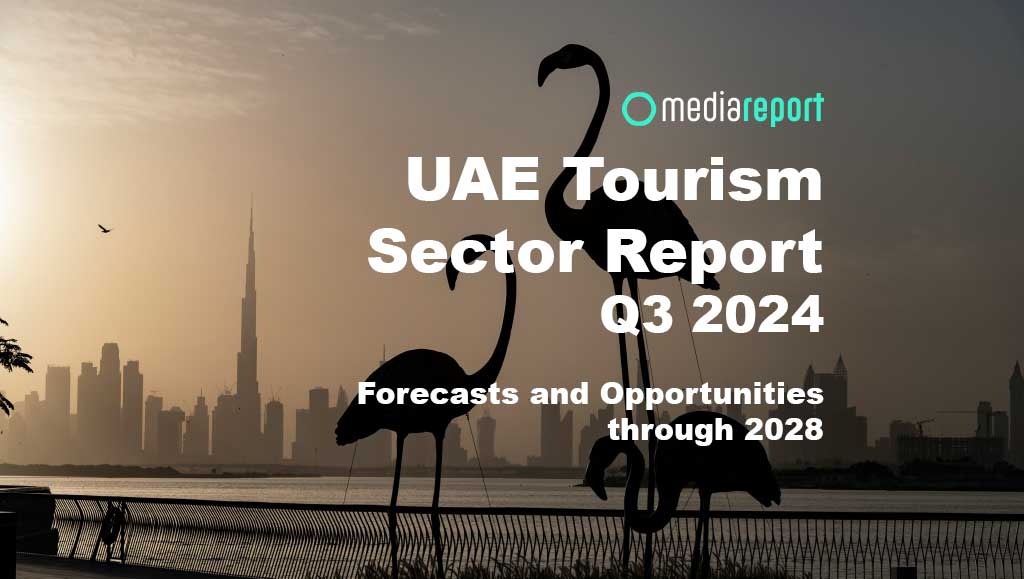UAE Tourism Sector: Forecasts and Opportunities Through 2028

UAE Tourism Sector: Forecasts and Opportunities Through 2028
Introduction:
The UAE tourism sector is set for substantial growth, driven by strategic initiatives, robust infrastructure, and diversified offerings. As detailed in Media-Report’s Q3 2024 Tourism Sector Report, the country’s tourism industry is poised to capitalize on its strategic location and world-class amenities, ensuring sustained success through 2028.
Key Highlights:
1. Strong Recovery from COVID-19:
- The UAE witnessed a significant rebound in tourist arrivals in 2023, signaling a full recovery from the pandemic. Effective government policies, extensive vaccination campaigns, and successful international events like Expo 2020 Dubai have fueled this resurgence.
2. Strategic Source Markets:
- Asia-Pacific: Expected to contribute 7.7 million tourists in 2024, driven by targeted marketing and strong air connectivity.
- Middle East: Projected to bring in 5.99 million tourists in 2024, supported by improved travel connections and reduced visa restrictions.
- Europe: Anticipated to add 5.97 million arrivals in 2024, boosted by the UAE’s robust air links and year-round appeal.
3. Government Initiatives and Investments:
- Continuous investments in tourism infrastructure, including airports, hotels, and entertainment facilities, are critical growth drivers. Initiatives like the Emirates Tourism Council are enhancing the sector’s appeal.
4. Diversification of Tourism Offerings:
- Expanding into cruise tourism, developing new cultural and entertainment attractions, and promoting lesser-known emirates such as Ras Al Khaimah and Fujairah are key strategies.
5. Enhanced Marketing and Promotions:
- Aggressive marketing campaigns in high-growth markets, particularly in India and China, are expected to yield positive results. The UAE’s use of digital platforms and collaborations with international travel agencies will enhance its visibility and attractiveness.
6. Resilience and Safety:
- The UAE’s reputation as one of the safest destinations in the Middle East, along with stringent health and safety protocols, continues to be a significant draw for international tourists.
7. Economic Diversification:
- The UAE’s efforts to diversify its economy away from oil dependency by developing its tourism sector as a major revenue generator are paying off. This strategy includes promoting luxury tourism, business travel, and medical tourism.
8. Positive Economic Indicators:
- Economic stability and growth in key source markets will support increased disposable incomes and travel propensity, further boosting tourist arrivals to the UAE.
Key Forecasts:
1. Tourist Arrivals:
- Tourist arrivals in the UAE are expected to grow by 14.4% year-on-year (y-o-y) in 2024, reaching 28.5 million visitors. This increase builds upon the estimated 24.9 million arrivals in 2023, reflecting the sector’s robust recovery and continued appeal.
- Over the medium term, the UAE is projected to witness an annual average growth rate of 7.1% y-o-y in tourist arrivals. By 2028, the total number of arrivals is forecasted to reach approximately 34.9 million.
2. International Tourism Receipts:
- International tourism receipts are projected to increase to USD 44.5 billion in 2024, up from the estimated USD 40.6 billion in 2023. This represents a 9.7% y-o-y growth, underpinned by higher spending per tourist and a diversified range of tourism offerings.
- The UAE’s international tourism receipts are expected to continue their upward trajectory, reaching USD 58.3 billion by 2028.
3. Arrivals by Region:
- Asia-Pacific: The Asia-Pacific region is anticipated to be the largest source of arrivals, with a projected 7.7 million visitors in 2024, growing to 8.8 million by 2028.
- Middle East: Arrivals from the Middle East are projected to reach 5.99 million in 2024, increasing to 6.7 million by 2028.
- Europe: European arrivals are forecasted at 5.97 million in 2024, growing to 6.8 million by 2028.
4. Tourist Spending:
- Average spending per tourist is expected to increase, contributing to higher overall tourism receipts. Efforts to attract high-spending segments, such as luxury travelers and business tourists, will play a significant role.
- The UAE aims to enhance the visitor experience and increase tourist spending through investments in new attractions, premium services, and comprehensive marketing strategies.
5. Cruise Tourism:
- Cruise tourism is projected to grow significantly, with major investments in cruise terminals and facilities in Dubai, Abu Dhabi, and Sharjah.
6. Hotel and Accommodation Sector:
- The UAE will have a projected 102.8 million total overnight stays in 2024, up from an estimated 97.3 million in 2023. The number of hotels and establishments is expected to grow from 1,350 in 2024 to 1,510 by 2028.
SWOT Analysis:
- Strengths: Strategic location, robust infrastructure, strong government support.
- Weaknesses: Over-reliance on Dubai and Abu Dhabi, regional geopolitical tensions.
- Opportunities: Growth in cruise tourism, diversification of tourist attractions, increasing arrivals from high-growth markets.
- Threats: Global economic uncertainties, potential oil price shocks, and rising travel costs.
Conclusion:
The UAE’s tourism sector is well-positioned for continued growth, supported by strategic initiatives, robust infrastructure, and diversified offerings. The nation’s ability to adapt to changing market dynamics and its commitment to providing a safe, attractive destination for global travelers will ensure its sustained success in the tourism industry.
Download the Full Report:
Explore Media-Report’s detailed analysis of the UAE tourism sector. Discover key growth drivers, strategic initiatives, and market forecasts through 2028. Learn how the UAE is set to thrive in the global tourism landscape.
Contact Us:
For more detailed insights and customized reports, contact Media-Report at contact@media-report.com.
